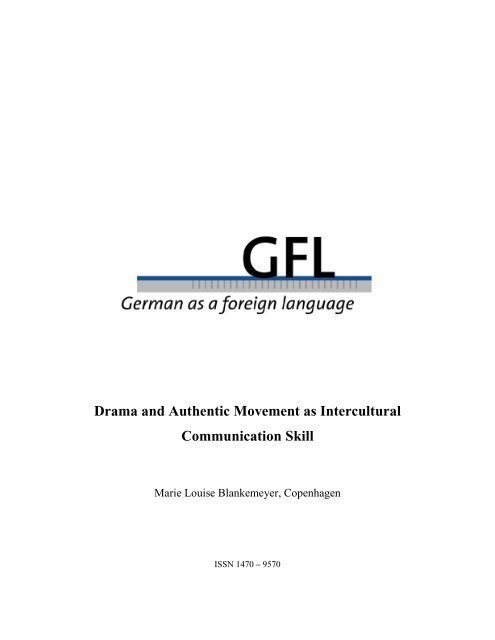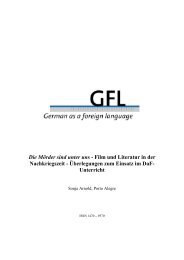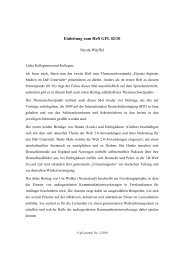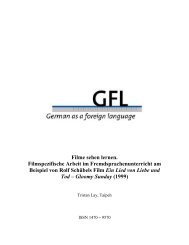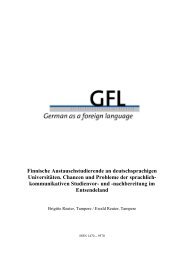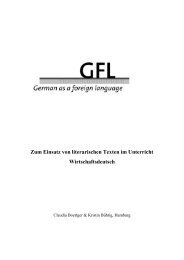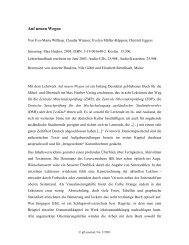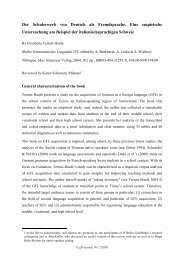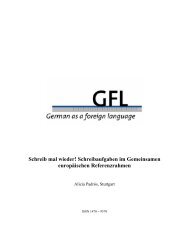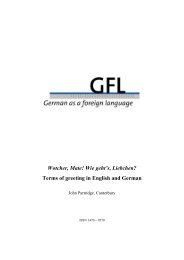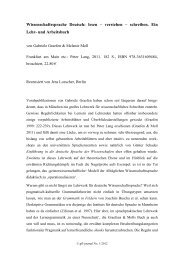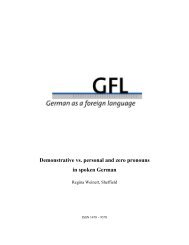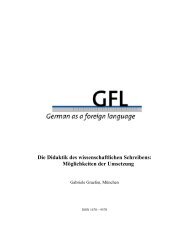Drama and Authentic Movement as Intercultural ... - GFL
Drama and Authentic Movement as Intercultural ... - GFL
Drama and Authentic Movement as Intercultural ... - GFL
You also want an ePaper? Increase the reach of your titles
YUMPU automatically turns print PDFs into web optimized ePapers that Google loves.
<strong>Drama</strong> <strong>and</strong> <strong>Authentic</strong> <strong>Movement</strong> <strong>as</strong> <strong>Intercultural</strong><br />
Communication Skill<br />
Marie Louise Blankemeyer, Copenhagen<br />
ISSN 1470 – 9570
Marie Louise Blankemeyer<br />
124<br />
<strong>Drama</strong> <strong>and</strong> <strong>Authentic</strong> <strong>Movement</strong> <strong>as</strong> <strong>Intercultural</strong> Communication Skill<br />
Marie Louise Blankemeyer, Copenhagen<br />
The following article describes a workshop held at the international conference “<strong>Drama</strong> <strong>and</strong><br />
Theatre in the Teaching <strong>and</strong> Learning of Language, Literature <strong>and</strong> Culture” at University<br />
College Cork, Irel<strong>and</strong>. Furthermore, it gives some background information about <strong>Authentic</strong><br />
<strong>Movement</strong> <strong>and</strong> its leading practitioners, <strong>as</strong> well <strong>as</strong> outlining how it is practised. Finally, the<br />
article considers how the principles of <strong>Authentic</strong> <strong>Movement</strong> can be applied to intercultural<br />
communication.<br />
1. Introduction<br />
How do people from different cultures engage with each other? How do you cope with<br />
something or somebody unknown, strange, new <strong>and</strong> different?<br />
One does not need to focus on two geographically <strong>and</strong> culturally widely disparate countries<br />
to encounter intercultural misunderst<strong>and</strong>ings. Even when people from two neighbouring,<br />
e.g. European countries meet for the first time, they usually do so with certain preconceived<br />
ide<strong>as</strong> about each other. These ide<strong>as</strong> derive from a combination of shared historic<br />
experience, the traditions of previous generations, a differing awareness of the present, the<br />
perception of tourists from a particular neighbouring country, the presentation of that<br />
country in the media, <strong>and</strong> a variety of other things.<br />
Facing another culture, the other, is a complex process, <strong>and</strong> long before language even<br />
begins to come into play, we perceive the body language, manner <strong>and</strong> appearance of the<br />
person we are dealing with. These perceptions may be influenced positively or negatively<br />
by our preconceived ide<strong>as</strong> <strong>and</strong> notions about a particular country. More often than not, we<br />
seek to find them confirmed in the other (person), <strong>and</strong> this fact in itself tends to counteract<br />
or, indeed, prevent any form of open-minded communication.<br />
Our workshop "<strong>Drama</strong> <strong>as</strong> intercultural communication skill. How to face the other" w<strong>as</strong><br />
intended to offer strategies which may help to create an atmosphere favourable to<br />
intercultural encounters. On the one h<strong>and</strong>, this workshop w<strong>as</strong> b<strong>as</strong>ed on didactic theatrical<br />
© gfl-journal, No. 1/2004
<strong>Drama</strong> <strong>and</strong> <strong>Authentic</strong> <strong>Movement</strong> <strong>as</strong> <strong>Intercultural</strong> Communication Skill<br />
125<br />
methods which have their origins in the work of such people <strong>as</strong> Stanislawski, Grotowski,<br />
Boal, Brook, <strong>and</strong> Mnouchkine. 1 On the other h<strong>and</strong>, the workshop drew some of its<br />
inspiration from the discipline of <strong>Authentic</strong> <strong>Movement</strong>, which originated in the field (<strong>and</strong><br />
from the experience) of Modern Dance <strong>and</strong> is employed in the context of dance therapy <strong>as</strong><br />
well <strong>as</strong> the performing arts. 2 It is also a discipline with potential for furthering the cause of<br />
intercultural encounters. It w<strong>as</strong> above all the <strong>Authentic</strong> <strong>Movement</strong> principle of nonjudgmental<br />
observation or witnessing that w<strong>as</strong> used for this workshop.<br />
The first part of the workshop focused on working at a pre-linguistic level, in an attempt to<br />
approach <strong>and</strong> tackle the following two questions:<br />
1) How do I face the other in an unbi<strong>as</strong>ed way?<br />
2) How do I deal with the other, with what is new <strong>and</strong> unfamiliar?<br />
Using drama exercises <strong>and</strong> principles from <strong>Authentic</strong> <strong>Movement</strong>, the workshop w<strong>as</strong><br />
designed to develop a number of suggestions for an unprejudiced form of making contact.<br />
2. <strong>Authentic</strong> <strong>Movement</strong><br />
The workshop centred on the methods of <strong>Authentic</strong> <strong>Movement</strong> which I describe below. In<br />
so doing I intend to outline the interrelationship between the practice of <strong>Authentic</strong><br />
<strong>Movement</strong> <strong>and</strong> intercultural skills.<br />
2.1 Background<br />
The practice of <strong>Authentic</strong> <strong>Movement</strong> w<strong>as</strong> initiated <strong>and</strong> named in the 1950s by the dancer<br />
Mary Starks Whitehouse <strong>and</strong> is continually in the process of being developed <strong>and</strong><br />
articulated. Two other women have made a significant contribution to the formation of the<br />
art of <strong>Authentic</strong> <strong>Movement</strong>: Janet Adler <strong>and</strong> Joan Chodorow.<br />
1<br />
Broadly speaking, all theatre directors referred to here have dealt with intercultural theatre<br />
forms. For further reading, see titles by Boal, Brook, Féral, Grotowski, Oida (Original title:<br />
“Hyoryu-Hyoru”, in which this Japanese actor describes the intercultural theatre experience<br />
derived from Brook´s (stage) work), Stanislawski.<br />
© gfl-journal, No. 1/2004
Marie Louise Blankemeyer<br />
126<br />
Mary Starks Whitehouse (1911-1979) received her diploma from the Wigman Central<br />
Institute in Dresden (an institute of the so-called Ausdruckstanz) <strong>and</strong> she w<strong>as</strong> also a student<br />
of Martha Graham. She studied at the C. G. Jung Institute in Switzerl<strong>and</strong> <strong>and</strong> w<strong>as</strong> a<br />
member of the American Dance Therapy Association, to mention only the main <strong>as</strong>pects of<br />
her rich background. Whitehouse conducted both a private movement therapy practice <strong>and</strong><br />
a movement therapy teacher program in Los Angeles. 3 She developed an approach to<br />
movement which is also called “authentic movement” or “movement in depth”.<br />
Janet Adler, PhD, a Californian dance/movement therapist <strong>and</strong> former student of Mary<br />
Starks Whitehouse <strong>and</strong> psychologist John Weir, teaches the discipline of <strong>Authentic</strong><br />
<strong>Movement</strong> internationally <strong>and</strong> w<strong>as</strong> the founder <strong>and</strong> director of the Mary Starks Whitehouse<br />
Institute, the first school devoted to the study <strong>and</strong> practice of <strong>Authentic</strong> <strong>Movement</strong>. She is<br />
the author of several publications, including The Offering from the Conscious Body. The<br />
Discipline of <strong>Authentic</strong> <strong>Movement</strong> 4 <strong>and</strong> director of the film Still Looking (1988) which<br />
reflects on her work in the discipline of <strong>Authentic</strong> <strong>Movement</strong>. She is a member of the<br />
<strong>Authentic</strong> <strong>Movement</strong> Institute in the San Francisco Bay Area which w<strong>as</strong> founded in 1993.<br />
Joan Chodorow, PhD, an analyst member of the C. G. Jung Institute of San Francisco, is a<br />
registered dance therapist <strong>and</strong> former president of the American Dance Therapy<br />
Association. Her early studies include dance studies, performance <strong>and</strong> teaching. She also<br />
studied with Mary Starks Whitehouse in the early 1960s. Since 1966 she h<strong>as</strong> written<br />
numerous articles <strong>and</strong> publications on the philosophy <strong>and</strong> practice of dance therapy. In<br />
addition to her private practice, she continues to write, teach <strong>and</strong> supervise students <strong>and</strong><br />
therapists. She h<strong>as</strong> also taught an intensive summer course in Switzerl<strong>and</strong> for many years. 5<br />
2<br />
For further reading see titles by Pallaro <strong>and</strong> Adler.<br />
3<br />
See Pallaro, Patrizia (ed.) (1999): <strong>Authentic</strong> <strong>Movement</strong>. Essays by Mary Starks Whitehouse,<br />
Janet Adler <strong>and</strong> Joan Chodorow, London <strong>and</strong> Philadelphia: Jessica Kingsley Publishers, 17-28.<br />
Chodorow, Joan (1996): “The Moving Imagination”. A Moving Journal. Ongoing Expressions of<br />
<strong>Authentic</strong> <strong>Movement</strong> 3, 2, 11-12.<br />
Uretsky, Lynne (1996): “On Language <strong>and</strong> <strong>Authentic</strong> <strong>Movement</strong>”. A Moving Journal. Ongoing<br />
Expressions of <strong>Authentic</strong> <strong>Movement</strong> 3, 2, 7-9.<br />
4<br />
Adler, Janet (2002): Offering from the Conscious Body. The Discipline of <strong>Authentic</strong> <strong>Movement</strong>,<br />
Vermont: Inner Traditions.<br />
5<br />
See Pallaro 1999: 209-228.<br />
© gfl-journal, No. 1/2004
<strong>Drama</strong> <strong>and</strong> <strong>Authentic</strong> <strong>Movement</strong> <strong>as</strong> <strong>Intercultural</strong> Communication Skill<br />
127<br />
Like Janet Adler, Joan Chodorow is a founding advisor of the <strong>Authentic</strong> <strong>Movement</strong><br />
Institute.<br />
<strong>Authentic</strong> <strong>Movement</strong> does not have a specific theoretical b<strong>as</strong>is. It h<strong>as</strong> evolved, <strong>and</strong><br />
continues to evolve, out of the exploratory work of its practitioners <strong>and</strong> is influenced by<br />
Modern Dance, Ausdruckstanz, <strong>as</strong> well <strong>as</strong> psychotherapeutic theories <strong>and</strong> methods. Dietmar<br />
E. Pall<strong>as</strong>ch describes in his PhD thesis within the field of dance therapy how he explored<br />
the similarities between <strong>Authentic</strong> <strong>Movement</strong> <strong>and</strong> related psychotherapeutic theories such<br />
<strong>as</strong> the theories of C.G. Jung, Arnold Mindell, Carl Rogers <strong>and</strong> Eugene Gendlin <strong>and</strong>, indeed,<br />
further research into this area is needed. 6<br />
2.2 The Form<br />
“<strong>Authentic</strong> <strong>Movement</strong> explores the relationship between a mover <strong>and</strong> a witness, being seen<br />
<strong>and</strong> seeing.” 7<br />
The b<strong>as</strong>ic form of <strong>Authentic</strong> <strong>Movement</strong> is a dyadic form which includes a mover <strong>and</strong> a<br />
witness. There is no movement instruction in <strong>Authentic</strong> <strong>Movement</strong>, simply a mover <strong>and</strong> a<br />
witness. These roles usually interchange within a session, except in a therapeutic context.<br />
During a set timed session, the mover closes his or her eyes <strong>and</strong> allows inner physical or<br />
vocal impulses to guide his or her movement. The mover’s eyes are closed in order to<br />
attend more deeply to his or her kinaesthetic or inner experience. The movements may or<br />
may not be visible to the witness. The movements <strong>and</strong>/or sounds may be in response to an<br />
emotion, a dream, a thought, pain, joy, or whatever is being experienced at a given<br />
moment. The witness sits on the edge of the movement space - in the c<strong>as</strong>e of a group, in a<br />
circle <strong>and</strong> attends to both the mover <strong>and</strong> his or her own internal responses to the movement.<br />
Chodorow 1996: 11-12.<br />
6<br />
Pall<strong>as</strong>ch, Dietmar E. (2002): Tief bewegt zum Ziel. Ein tanztherapeutischer Ansatz aus NLP und<br />
<strong>Authentic</strong> <strong>Movement</strong>, Bielefeld: Junfermann Verlag, 6, 10-11.<br />
7<br />
Introduction on the homepage of the <strong>Authentic</strong> <strong>Movement</strong> Institute in San Francisco,<br />
http://www.authenticmovement-usa.com<br />
© gfl-journal, No. 1/2004
Marie Louise Blankemeyer<br />
128<br />
The witness serves <strong>as</strong> a comp<strong>as</strong>sionate, non-judgmental mirror. Afterwards, the two speak<br />
about their experiences. The mover speaks first, followed by feedback from the witness. 8<br />
“The mover is the expert. The mover speaks before the witness. The witness doesn’t refer<br />
to any material before the mover h<strong>as</strong>. We must own our judgments, projections <strong>and</strong><br />
interpretations.” 9<br />
Within the framework of specific guidelines mover <strong>and</strong> witness can communicate with each<br />
other in a safe <strong>and</strong> comp<strong>as</strong>sionate context. The guidelines free the mover <strong>and</strong> the witness<br />
from judgement, projection <strong>and</strong> interpretation.<br />
The guidelines for both mover <strong>and</strong> witness: 10<br />
1) I see observations b<strong>as</strong>ed on the actual movement of the mover<br />
2) I sense sensations of the body (kinaesthetic sensations in the body)<br />
3) I feel emotion<br />
4) I imagine image/story<br />
In the following description of the guidelines, I will concentrate on the witnessing <strong>as</strong>pect,<br />
which seems to be the most difficult <strong>and</strong> dem<strong>and</strong>ing part.<br />
1) The witness describes what he/she h<strong>as</strong> seen b<strong>as</strong>ed on the actual movement of the mover.<br />
It is important not to use interpretations (e. g. adjectives) but to concentrate on the actual<br />
description of physical movement, e. g. “I see you lifting your right arm”.<br />
2) The witness notices sensations in his or her own body <strong>and</strong> may or may not share them<br />
with the mover, e. g. “I sense the contraction of my own biceps in my right arm”.<br />
3) The witness may or may not share his or her feelings with the mover, e. g. “I feel tired<br />
<strong>and</strong> sad while seeing you lifting your arm”.<br />
8<br />
See Bauer, Susanne (2002): “Mindfulness in Motion”. In Touch, A Quarterly Newsletter<br />
Exploring Touch, Healing <strong>and</strong> Consciousness, Autumn 2002, 3.<br />
9<br />
Geissinger, Annie (1998): “Towards the Unknown. An Interview with Janet Adler”. A Moving<br />
Journal. Ongoing Expressions of <strong>Authentic</strong> <strong>Movement</strong>. The Collective 5, 3, 4-10.<br />
10 The specific guidelines <strong>as</strong> they appear here were p<strong>as</strong>sed on <strong>as</strong> a teaching instruction during my<br />
training with Linda Hartley. But the guidelines are also embedded in Janet Adler’s book Offering<br />
from the Conscious Body. See the first chapter “Individual Body”, especially pp. 34 – 36.<br />
© gfl-journal, No. 1/2004
<strong>Drama</strong> <strong>and</strong> <strong>Authentic</strong> <strong>Movement</strong> <strong>as</strong> <strong>Intercultural</strong> Communication Skill<br />
129<br />
4) The witness may or may not share a particular perception of the mover’s movement, e. g.<br />
“I imagine a wounded animal lying on the ground lifting his foreleg”.<br />
These four principles are not always present in a feedback round. The most important part<br />
is to start off with the description of the movement <strong>and</strong> then follow it up with the other<br />
<strong>as</strong>pects of the witness’s experience. The witness speaks in the first person singular to make<br />
sure that the feedback stays with him/her <strong>and</strong> to allow the mover the opportunity of<br />
agreeing or disagreeing with his/her response. The witness always speaks in the present<br />
tense <strong>and</strong> <strong>as</strong>ks the mover whether he/she wants to hear any feedback. If the witness is not<br />
sure about what he/she h<strong>as</strong> seen or h<strong>as</strong> forgotten parts of the sequence, it may be enough to<br />
say: “I see you” or “I hear you”.<br />
<strong>Authentic</strong> <strong>Movement</strong> is practised in many varied contexts such <strong>as</strong> psychotherapy,<br />
personal/creative investigation <strong>and</strong> <strong>as</strong> a source of original artistic creation in dance, theatre,<br />
writing <strong>and</strong> the visual arts.<br />
3. <strong>Authentic</strong> <strong>Movement</strong> <strong>as</strong> an intercultural communication skill – an approach<br />
The principles of <strong>Authentic</strong> <strong>Movement</strong> <strong>and</strong>, above all, the witnessing <strong>as</strong>pect appear to be<br />
particularly helpful in an intercultural context. In combination with exercises drawn from<br />
drama-in-education, a foundation may be laid for initiating non-verbal contact, which may<br />
then be exp<strong>and</strong>ed to include some form of verbal exchange. The emph<strong>as</strong>is here is precisely<br />
on the initial non-verbal impressions, the messages of body language that may prove<br />
decisive in opening channels of communication. Embedding <strong>Authentic</strong> <strong>Movement</strong> in an<br />
intercultural context is a new approach to intercultural encounters which h<strong>as</strong> yet to be<br />
explored on a more theoretical b<strong>as</strong>is.<br />
To begin with, it seems essential to offer simple exercises in order to enable all participants<br />
to make contact with one another. During our workshop in Irel<strong>and</strong>, the participants were<br />
encouraged to do simple walking exercises with their eyes open or closed, with or without a<br />
partner. They began their search for a partner with their eyes open, i.e. quite consciously.<br />
One of the exercises encouraged the participants to meet <strong>and</strong> greet each other. Here they<br />
had to focus on how they wanted to greet the other person: did they want to shake h<strong>and</strong>s,<br />
© gfl-journal, No. 1/2004
Marie Louise Blankemeyer<br />
130<br />
did they want to embrace the other person, to rub their noses or simply stay in eye contact<br />
<strong>and</strong> say “hello”? The purpose w<strong>as</strong> to find out what kind of distance or proximity each one<br />
of the participants wanted to have to the others they encountered. Since the cultural<br />
greeting vocabulary is different in every country, it is important to find out where the<br />
individual feels comfortable while greeting the other. In the framework of a workshop we<br />
can experiment with proximity <strong>and</strong> distance while learning to have a non-judgmental<br />
attitude towards our partner. During the next stage, the participants relied on other senses,<br />
mainly their sense of touch, in trying to find a partner blindly with their h<strong>and</strong>s. As we<br />
discussed this later on, it w<strong>as</strong> interesting to see whether the same partner had been chosen<br />
or whether one´s blind choice had been anticipated, <strong>and</strong> what conclusions were to be drawn<br />
from that fact.<br />
The principal of non-judgmental observation w<strong>as</strong> made use of in a very simple drama<br />
exercise: one of the participants crosses the stage at his/her own speed with open eyes,<br />
moving towards the circle of witnesses. The person who volunteered may then comment on<br />
what he/she experienced crossing the stage <strong>and</strong> facing the witnessing audience. Next the<br />
witnesses render their observations, trying to make sure that any kind of evaluation – either<br />
positive or negative – is carefully avoided. The first step is an exact description of the<br />
purely physical act of walking. This may be repeated several times with different volunteers<br />
in order to practise the act of watching. In our workshop, there w<strong>as</strong> one occ<strong>as</strong>ion when two<br />
participants crossed the stage engaging in a non-verbal dialogue both with each other <strong>and</strong><br />
the witnesses.<br />
This exercise w<strong>as</strong> followed up by an exchange of views in the workshop group. Not<br />
surprisingly, impressions <strong>and</strong> emotions which derived from witnessing the movements on<br />
the stage varied among the participants. And here further issues of interest emerge that<br />
could be explored more systematically: where do the boundaries between intercultural <strong>and</strong><br />
simply interpersonally rooted perception lie? Is it possible to identify <strong>and</strong> isolate particular<br />
<strong>as</strong>pects that influence the way human beings perceive one another’s gestures, expressions<br />
<strong>and</strong> movements? And – are there factors which can be attributed solely to the diversity of<br />
cultural backgrounds at all?<br />
© gfl-journal, No. 1/2004
<strong>Drama</strong> <strong>and</strong> <strong>Authentic</strong> <strong>Movement</strong> <strong>as</strong> <strong>Intercultural</strong> Communication Skill<br />
131<br />
Just formulating these questions is bound to raise even more questions, illustrating the<br />
complexity of this field of interest <strong>and</strong> the necessity for further scientific exploration.<br />
Finding <strong>and</strong> sketching the corner stones of this field is in itself a challenging t<strong>as</strong>k. Two<br />
central questions may be worth noting here: is it always the intercultural <strong>as</strong>pect that plays a<br />
key role in intercultural misunderst<strong>and</strong>ing <strong>and</strong> how can we identify it? <strong>Authentic</strong><br />
<strong>Movement</strong> could be another tool in developing an approach to answer these questions.<br />
Sixteen people from different European countries attended the workshop: language<br />
teachers, university lecturers, lecturers in drama-in-education <strong>and</strong> other people dealing with<br />
pedagogical <strong>and</strong> intercultural issues mentioned above. Due to time constraints I introduced<br />
<strong>and</strong> practised only the first guideline mentioned above. The other three were mentioned but<br />
not practised. However, the exercises done provided a means of experiencing the field of<br />
non-verbal intercultural <strong>and</strong> interpersonal underst<strong>and</strong>ing.<br />
4. Conclusion<br />
When trying to achieve intercultural communication the realisation that a particular gesture<br />
or posture may have a particular meaning for oneself <strong>and</strong> an entirely different one for<br />
another person is an essential b<strong>as</strong>is to start out from. As we move on to speech <strong>and</strong><br />
behaviour the individual differences incre<strong>as</strong>e, making it even more important to be very<br />
sensitive <strong>and</strong> clear from the beginning. The <strong>as</strong>pect of “(cultural) awareness” w<strong>as</strong> an issue<br />
which we discussed in the final round of our workshop, concentrating on the guidelines of<br />
<strong>Authentic</strong> <strong>Movement</strong>. What all participants came to realise w<strong>as</strong> how difficult it w<strong>as</strong> for<br />
them to exclusively observe a mover. Being a witness <strong>and</strong> a non-judgmental mirror w<strong>as</strong> a<br />
much more difficult t<strong>as</strong>k than the participants had expected.<br />
The guidelines of <strong>Authentic</strong> <strong>Movement</strong> offer a way of meeting the other in a safe<br />
framework. In everyday life, projections, interpretations <strong>and</strong> judgments fill our thoughts<br />
<strong>and</strong> may e<strong>as</strong>ily be an obstacle to any open-minded communication. Especially in an<br />
international context you may meet a ‘confusion of body-languages’ which often leads to<br />
misunderst<strong>and</strong>ings. We tend to interpret the other’s body language <strong>and</strong> behaviour from the<br />
perspective of our own social <strong>and</strong> cultural background <strong>and</strong> this may be a major re<strong>as</strong>on for<br />
mutual misunderst<strong>and</strong>ings. In using <strong>and</strong> practising the principles of <strong>Authentic</strong> <strong>Movement</strong>,<br />
© gfl-journal, No. 1/2004
Marie Louise Blankemeyer<br />
132<br />
each one of us may experience the role of the mover <strong>and</strong> the witness. The practice of merely<br />
watching the other’s actual movements – without taking a judgmental attitude but with an<br />
awareness that pictures <strong>and</strong> interpretations are rooted in ourselves <strong>and</strong> our personal, social<br />
<strong>and</strong>/or cultural background - might have a liberating effect on our meeting the other on a<br />
b<strong>as</strong>is of mutual underst<strong>and</strong>ing.<br />
<strong>Authentic</strong> <strong>Movement</strong> may be exploited yet further in the area of intercultural<br />
communication. Following specific instructions, it may be practised either it in its original<br />
form 11 or used in combination with drama-in-education techniques. No doubt further<br />
research, testing <strong>and</strong> in-depth study will be necessary. However, our workshop in Irel<strong>and</strong><br />
w<strong>as</strong> clearly indicative of the applicability <strong>and</strong> the usefulness of the method in this field.<br />
Bibliography<br />
Adler, Janet (2002): Offering from the Conscious Body. The Discipline of <strong>Authentic</strong><br />
<strong>Movement</strong>. Vermont: Inner Traditions.<br />
Bauer, Susanne (2002): “Mindfulness in Motion”. In Touch, A Quarterly Newsletter<br />
Exploring Touch, Healing <strong>and</strong> Consciousness, Autumn 2002, p. 3.<br />
Boal, Augusto (1989): Theater der Unterdrückten, Übungen und Spiel für Schauspieler und<br />
Nicht-Schauspieler. Frankfurt am Main: Suhrkamp Verlag.<br />
Boal, Augusto (1999): Der Regenbogen der Wünsche, Methoden aus Theater und Therapie.<br />
Seelze: Kallmeyer Verlag.<br />
Brook, Peter (2001): Der leere Raum. Berlin: Alex<strong>and</strong>er Verlag.<br />
Chodorow, Joan (1996): “The Moving Imagination”. A Moving Journal. Ongoing<br />
Expressions of <strong>Authentic</strong> <strong>Movement</strong> 3, 2, pp. 11-12.<br />
Geissinger, Annie (1998): “Towards the Unknown. An Interview with Janet Adler”. A<br />
Moving Journal. Ongoing Expressions of <strong>Authentic</strong> <strong>Movement</strong>. The Collective 5, 3,<br />
pp. 4-10.<br />
Grotowski, Jerzy (1986): Für ein armes Theater. Zürich: Orell Füssli.<br />
Féral, Josette (2002): Ariane Mnouchkine und d<strong>as</strong> Théatre du Soleil. Berlin: Alex<strong>and</strong>er<br />
Verlag.<br />
Oida, Yoshi (1993): Zwischen den Welten. Mit einem Vorwort von Peter Brook. Berlin:<br />
Alex<strong>and</strong>er Verlag.<br />
Pallaro, Patrizia (ed.) (1999): <strong>Authentic</strong> <strong>Movement</strong>. Essays by Mary Starks Whitehouse,<br />
Janet Adler <strong>and</strong> Joan Chodorow. London <strong>and</strong> Philadelphia: Jessica Kingsley<br />
Publishers.<br />
11<br />
See section 2.2: <strong>Authentic</strong> <strong>Movement</strong> – The Form<br />
© gfl-journal, No. 1/2004
<strong>Drama</strong> <strong>and</strong> <strong>Authentic</strong> <strong>Movement</strong> <strong>as</strong> <strong>Intercultural</strong> Communication Skill<br />
133<br />
Pall<strong>as</strong>ch, Dietmar E. (2002): Tief bewegt zum Ziel. Ein tanztherapeutischer Ansatz aus NLP<br />
und <strong>Authentic</strong> <strong>Movement</strong>. Bielefeld: Junfermann Verlag.<br />
Stanislawski, Konstantin S. (1999): Die Arbeit des Schauspielers an der Rolle. Hg. v.<br />
Dieter Hoffmeier. Berlin: Henschel Verlag.<br />
Uretsky, Lynne (1996): “On Language <strong>and</strong> <strong>Authentic</strong> <strong>Movement</strong>”. A Moving Journal.<br />
Ongoing Expressions of <strong>Authentic</strong> <strong>Movement</strong>.3, 2, pp. 7-9.<br />
Biodata<br />
Marie Louise Blankemeyer holds an M.A. in Angew<strong>and</strong>te Kulturwissenschaften <strong>and</strong> a<br />
certificate in <strong>Drama</strong>-in-Education from University of Lüneburg <strong>and</strong> a certificate in<br />
Integrative Bodywork <strong>and</strong> <strong>Movement</strong> Therapy from Tanzinitiative Hamburg e. V. TRIADE,<br />
Zentrum für Tanz und Performance, <strong>Authentic</strong> <strong>Movement</strong> having formed an integral part of<br />
the latter qualification <strong>and</strong> with Linda Hartley (Great Britain) being her main teacher.<br />
B<strong>as</strong>ed in Denmark, she does freelance project work for the Goethe Institut, Copenhagen, <strong>as</strong><br />
well <strong>as</strong> organising <strong>and</strong> giving workshops on <strong>Authentic</strong> <strong>Movement</strong>, drama-in-education <strong>and</strong><br />
breathing <strong>and</strong> vocal techniques.<br />
Contact: ml.blankemeyer@gmx.net<br />
Recent Publication: Georgia Herlt/Marie Louise Blankemeyer (2003): Abenteuer<br />
Deutschl<strong>and</strong>. Dänen im Nachbarl<strong>and</strong>. Kopenhagen: Goethe Institut.<br />
© gfl-journal, No. 1/2004


